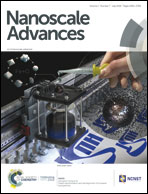Hydrogen generation from a sodium borohydride–nickel core@shell structure under hydrolytic conditions†
Abstract
Sodium borohydride (NaBH4) is an attractive hydrogen carrier owing to its reactivity with water: it can generate 4 equivalents of H2 by hydrolysis (NaBH4 + 4H2O → NaB(OH)4 + 4H2). Since using NaBH4 in the solid state is the most favorable way to achieve a high gravimetric hydrogen storage capacity (theoretical maximum of 7.3 wt%), we have investigated the possibility of developing a core@shell nanocomposite (NaBH4@Ni) where a metallic nickel catalyst facilitating the hydrolysis is directly supported onto NaBH4 nanoparticles. Following our initial work on core–shell hydrides, the successful preparation of NaBH4@Ni has been confirmed by TEM, EDS, IR, XRD and XPS. During hydrolysis, the intimately combined Ni0 and NaBH4 allow the production of H2 at high rates (e.g. 6.1 L min−1 g−1 at 39 °C) when water is used in excess. After H2 generation, the spent fuel is composed of an aqueous solution of NaB(OH)4 and a nickel-based agglomerated material in the form of Ni(OH)2 as evidenced by TEM, XPS and XRD. The effective gravimetric hydrogen storage capacity of nanosized NaBH4@Ni has been optimized by adjusting the required amount of water for hydrolysis and an effective hydrogen capacity of 4.4 wt% has been achieved. This is among the best reported values.



 Please wait while we load your content...
Please wait while we load your content...